Cannabis Cultivation in Urban Settings
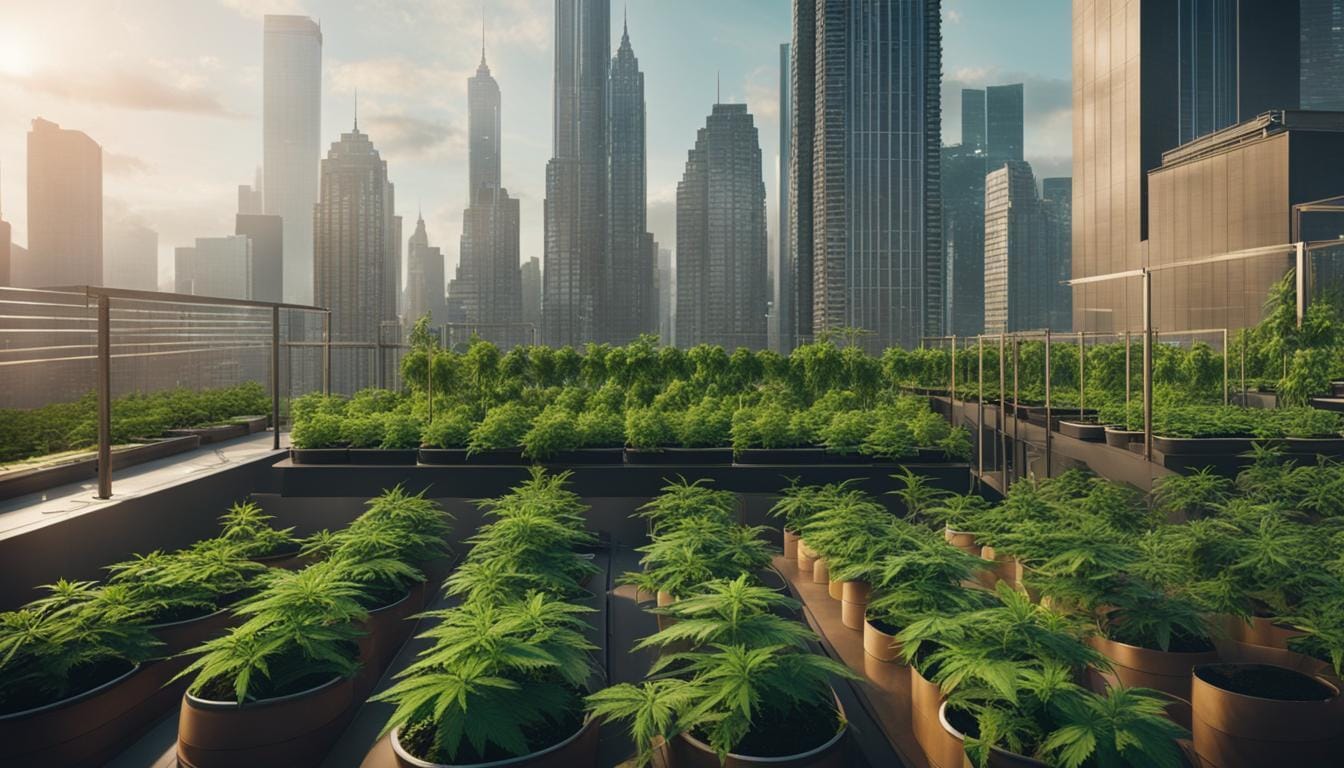
When it comes to growing cannabis, environmental conditions are everything. As such, cannabis cultivation in urban settings can be a challenge, especially in small gardens.
Whether you have a tiny apartment or a rooftop garden, you can still grow cannabis plants and maximize your yield. In this article, we will guide you through the unique challenges and advantages of urban cannabis farming. From selecting the right strain to maximizing space efficiency, we’ll cover everything you need to know to grow cannabis successfully in an urban setting.
Key Takeaways:
- Urban cannabis cultivation is possible in small-space environments
- Choosing the right strain is crucial for successful urban cannabis growing
- Indoor cultivation is a popular choice for urban cannabis growers
- Maximizing space efficiency is vital for urban cannabis farming techniques
- Pest and disease management is essential for urban cannabis cultivation
Understanding Cannabis Cultivation in Urban Settings
Growing cannabis in urban environments presents a unique set of challenges and advantages. As an urban cannabis farmer, I have learned to navigate limited space, security concerns, and other obstacles to maximize my yield. I will share my insights on urban farming and cultivation in this section.
What is Urban Cannabis Farming?
Urban cannabis farming refers to the practice of cultivating cannabis in cities and other urban environments. With limited outdoor space, urban cannabis farmers often have to improvise with indoor growing techniques, such as hydroponics and vertical gardening.
The Advantages of Urban Cannabis Farming
Despite its challenges, indoor urban cannabis farming offers several advantages. For one, it allows for discreet cultivation, which is essential in areas where cannabis cultivation is not yet legal. Moreover, urban farmers have greater control over the growing environment, from lighting to humidity and temperature control. This leads to healthier plants and higher yields.
The Challenges of Urban Cannabis Farming
One of the most significant challenges of urban cannabis farming is limited space. Urban farmers often rely on indoor growing techniques with fewer outdoor areas. This can be expensive and require special equipment and knowledge. Additionally, indoor growing can pose a significant security risk, as cannabis plants emit a strong odor that can attract unwanted attention.
Overcoming the Obstacles: Tips for Urban Cannabis Cultivation
Urban cannabis farmers can overcome these obstacles by implementing the following urban cannabis tips:
- Choose the right strain: Select strains suitable for small-space environments, such as indica or autoflower varieties.
- Maximize space efficiency: Utilize vertical gardening techniques and consider hydroponics for more efficient use of space.
- Control lighting: Use natural sunlight and/or use artificial lighting systems to maximize plant growth.
- Prevent pests and diseases: Regularly inspect your plants for pests and diseases and take preventative measures such as using insecticidal soap or neem oil.
- Maintain discretion: Use odor control methods such as carbon filters, and be mindful of your growing setup’s visibility to outsiders.
By following these tips, urban cannabis farmers can successfully cultivate high-quality cannabis in even the smallest of spaces.
“Urban cannabis farming offers several advantages. For one, it allows for discreet cultivation, which is essential in areas where cannabis cultivation is not yet legal.”
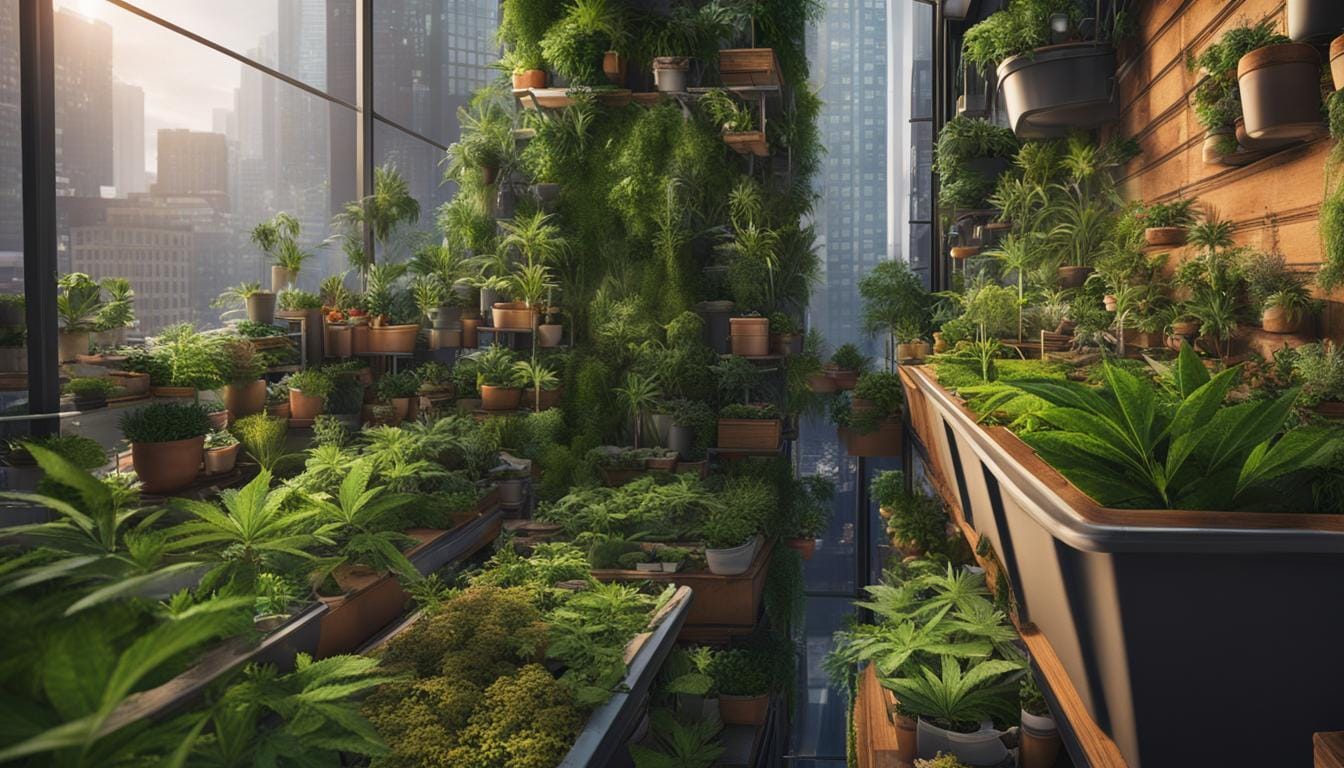
Choosing the Right Strain for Urban Cultivation
Urban cannabis growing requires careful strain selection to ensure the healthy cultivation of your cannabis garden. Some strains are better suited for small-space environments, while others thrive in larger outdoor settings. To make the most of your urban cannabis garden, consider the following factors when selecting a strain:
Size
The size of your cannabis plant is a crucial consideration for urban cultivation. If you have limited space, choosing a strain that stays relatively small throughout its growth cycle is best. Indica strains are shorter and bushier, making them an excellent choice for small-space environments. On the other hand, Sativa strains tend to grow taller and more lanky, so they may not be the best choice for urban cultivation unless you have high ceilings.
Yield
When growing cannabis in an urban setting, you want to maximize your yield while minimizing your space usage. As such, selecting a strain with a high yield potential is essential. However, remember that high-yielding strains often require more space to grow properly, so finding a balance between yield and space efficiency is critical.
Flowering Time
The growing time of a strain is another crucial factor to consider when selecting a strain for urban cultivation. Some strains have extended flowering periods compared to others, meaning they take longer to mature and require more space and resources. Conversely, some strains have shorter growing times, making them more suitable for small-space environments. Autoflowering strains are an excellent choice for urban cannabis gardening since they have a shorter life cycle and take up less space.
Growing Difficulty
Some cannabis strains are more challenging to grow than others, which can be problematic for urban cultivators who may not have as much experience or resources as larger outdoor growers. As such, selecting a strain that is relatively easy to grow and adaptable to small-space environments is essential. Look for strains that are low-maintenance, pest-resistant, and require minimal attention to thrive.
By considering these factors, you can select the right strain for your urban cannabis garden and optimize your cultivation process. Remember to research different strains thoroughly and experiment with other varieties to find the best ones for your unique situation.
The Best USA Seed Bank
When it comes to urban cannabis cultivation techniques, choosing the right strain from the best USA seed bank is essential. One of the most trusted and reputable seed banks in the country is SeedsHereNow.com.
Seeds Here Now offers a vast selection of high-quality cannabis seeds, including regular, feminized, and autoflowering strains. We source our seeds from the most reputable breeders in the industry, ensuring excellent genetics and consistent quality.
Moreover, Seeds Here Now provides excellent customer service and support, with our knowledgeable and friendly staff available to answer any questions or concerns. We also offer discreet and secure shipping, ensuring your seeds arrive safely and on time.
Whether you’re a seasoned urban cannabis grower or just starting, Seeds Here Now is undoubtedly one of the best USA seed banks to consider for your next harvest.
Indoor Cultivation in Urban Settings
Indoor cultivation is a popular choice for urban cannabis growers because it allows for more control over the growing environment. This section will provide a comprehensive guide on setting up an indoor grow space in your urban setting and offer some urban cannabis cultivation techniques to help you get the most out of your indoor garden.
First, discuss the space you’ll need for indoor cannabis cultivation. Ideally, you want an area with enough room for your plants to grow, proper ventilation, and access to electricity. If you don’t have a spare room, consider converting a closet or building a small grow tent.
Next, you’ll need to focus on lighting. Grow lights are essential for indoor cannabis cultivation as they promote photosynthesis and simulate the sun’s energy. LED lights are the most energy-efficient option, while high-pressure sodium (HPS) lights are the most popular. In addition to the type of light, you’ll need to consider the light’s intensity, duration, and distance from your plants to ensure optimal growth.
Temperature and humidity control are also crucial for indoor cannabis cultivation. You want to keep your grow room at a consistent temperature between 68 and 77 degrees Fahrenheit during the day and 58 and 70 degrees Fahrenheit at night. The humidity level should be kept around 50 percent to 60 percent during the vegetative stage and reduced to 40 percent to 50 percent during the flowering stage.
Air circulation is necessary to prevent mold and mildew growth and ensure your plants have access to fresh air. Fans and carbon filters can circulate air through your grow space.
Lastly, you must choose the right soil or hydroponic system for your indoor plants. Soil is more forgiving and is recommended for beginners, but hydroponics can produce faster growth and bigger yields. Either way, you must ensure your plants receive proper nutrients and water to thrive.
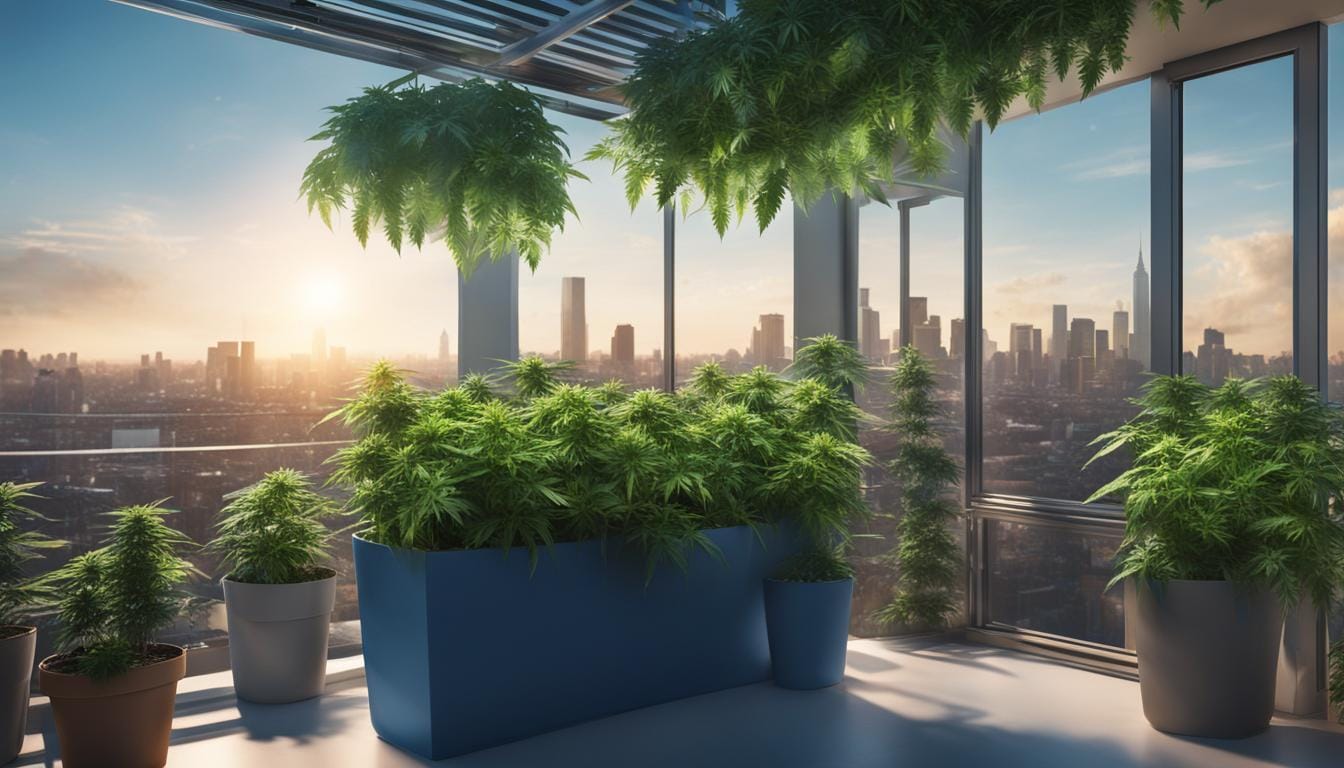
Maximizing Yield Indoors
Now that you have a better understanding of the basics of indoor cannabis cultivation, let’s dive into some urban cannabis cultivation techniques to help you maximize your yield:
- Use the Sea of Green (SOG) technique to grow more plants in less space. SOG involves growing multiple smaller plants instead of a few larger plants, allowing you to utilize your limited space more efficiently.
- Implement high-stress training (HST) techniques to increase yield and control plant height. HST involves using methods like topping, super cropping, and bending to create more bud sites and spread your plant’s growth.
- Consider using hydroponics for faster growth and bigger yields. Hydroponics allows more control over nutrients and watering and can produce faster and more substantial results than traditional soil-based methods.
- Use a scrog net to maximize your canopy and light exposure. A scrog net allows you to train your plants to grow horizontally and spread out, maximizing their exposure to light and ultimately resulting in a larger yield.
| Advantages of Indoor Cannabis Cultivation in Urban Settings | Disadvantages of Indoor Cannabis Cultivation in Urban Settings |
|---|---|
| More control over the growing environment | Higher upfront costs for equipment and setup |
| Ability to grow year-round | Requires more maintenance and attention |
| Less susceptible to pests and diseases | Electricity costs can be high |
| Produces higher quality, more potent buds | It can be difficult to disguise the smell |
With the right equipment, knowledge, and techniques, you can successfully grow cannabis in an indoor urban setting. Remember to start small and scale up as you become more comfortable with the process. Good luck!
Maximizing Space Efficiency
When it comes to urban cannabis farming, space is at a premium. As an urban cannabis grower, maximizing every inch of your growing area is essential. Here are some space-saving techniques that are perfect for urban cannabis growers:
Vertical Gardening
Vertical gardening is a popular technique for urban cannabis growers. Using a trellis or other support structure, you can train your plants to grow upwards, rather than outwards. This is a great way to maximize your growing area, particularly if you have limited floor space.
One of the benefits of vertical gardening is the increased air circulation around your plants. This can help prevent pest and disease problems and improve overall plant health. Additionally, vertical gardening can make it easier to access your plants for pruning and harvesting.
Hydroponics
Hydroponics is a soil-less growing method ideal for urban cannabis farmers. Instead of soil, hydroponic systems use a nutrient-rich water solution to feed the plants. This allows for faster growth and greater yields, as the plants can absorb nutrients more efficiently.
Hydroponic systems can be set up in various ways, including using a drip or ebb-and-flow system. Some are even designed to be stackable, making them perfect for urban growers with limited space.
Creative Containers
Another way to maximize space efficiency is by using creative containers for your plants. This can include anything from repurposing old buckets or plastic containers to using hanging baskets or tiered plant stands.
When choosing containers, consider the size of your plants and the amount of space they will need to grow. You should also choose containers with proper drainage to prevent water buildup, which can lead to root rot.
Comparing Space-Efficient Techniques
| Technique | Pros | Cons |
|---|---|---|
| Vertical Gardening | Maximizes vertical growing space | Requires additional support structures |
| Hydroponics | Faster growth and greater yields | Requires additional equipment and setup |
| Creative Containers | Flexible and customizable | It may not be as efficient as other methods |
As an urban cannabis farmer, it is essential to choose the space-efficient techniques that work best for your specific needs. These techniques can maximize your growing area and increase your yield while growing cannabis in a small space.
Nutrients and Soil Preparation
Providing cannabis plants with the proper nutrients and soil preparation is essential for healthy growth. Soil quality is critical for urban cannabis cultivation. High-quality soil is necessary for optimal growth since urban environments often have poor soil quality.
Before planting, it’s crucial to test the soil pH and ensure it falls within the optimal range of 6.0 to 7.0. If the pH level is too high or too low, it can affect the plant’s ability to absorb nutrients, leading to stunted growth or even plant death.
Mix in organic compost and other soil amendments to prepare the soil for planting to improve drainage and water retention. Avoid using uncomposted manure as it can contain harmful bacteria that can harm your plants.
Nutrient Requirements
Urban cannabis cultivation requires a balanced nutrient mix to ensure optimal growth. In general, cannabis plants require three primary macronutrients—Nitrogen (N), Phosphorus (P), and potassium (K)—and several micronutrients, including iron, magnesium, and zinc.
| Macronutrient | Function | Deficiency Symptoms |
|---|---|---|
| Nitrogen (N) | Promotes leafy growth and photosynthesis | Yellowing of leaves, slowed growth |
| Phosphorus (P) | Encourages root growth, flowering, and fruit development | Stunted growth, weak roots, purple discoloration |
| Potassium (K) | Regulates plant metabolism and water uptake | Burnt leaf tips, weak stems |
Over-fertilizing can adversely affect your plants, leading to nutrient burn and stunted growth. To prevent this, it is best to start with a lower dosage and gradually increase as needed. Synthetic Nutrients.
When choosing nutrients, you have two options: organic and synthetic. Organic nutrients are derived from natural sources, such as compost and worm castings, and provide slow-release nutrients over time. On the other hand, synthetic nutrients are manufactured and provide fast-acting nutrients that the plant quickly absorbs.
While both options can be effective, organic nutrients are often preferred for urban cannabis gardening as they are considered safer and more sustainable for the environment.
Pest and Disease Management
When it comes to urban cannabis cultivation, managing pests and diseases is critical to ensuring a successful yield. Urban areas often have higher populations of pests and diseases, making it crucial to take preventative measures and address any issues immediately.
One effective strategy for preventing pest and disease problems is to keep your grow area clean and tidy. Remove any dead plant material or debris, as these can attract pests and provide a breeding ground for diseases. Regularly sanitize your growing containers and tools to prevent the spread of harmful pathogens.
In addition to preventative measures, it’s essential to identify common pests and diseases that can affect your plants. Some common pests that affect urban cannabis cultivation include spider mites, whiteflies, and thrips. These pests can cause significant damage to your plants if left unchecked.
| Pest | Symptoms | Treatment |
|---|---|---|
| Spider Mites | – Small white or yellow speckles on leaves – Fine webbing on leaves and between branches |
– Neem oil – Insecticidal soap |
| Whiteflies | – Yellowing leaves – Sticky residue on leaves |
– Sticky tape or traps – Insecticidal soap |
| Thrips | – Silver or bronze scars on leaves – Discoloration on leaves |
– Neem oil – Insecticidal soap |
Diseases can also significantly threaten your urban cannabis garden. Common diseases include powdery mildew, botrytis, and root rot, which can be caused by poor ventilation, high humidity, and overwatering.
If you notice any signs of pests or diseases in your plants, acting quickly to prevent the problem from spreading is crucial. Depending on the severity of the issue, you may need to use pesticides or fungicides to address the problem. However, using these products responsibly and following the manufacturer’s instructions carefully is essential.
Indeed, pest and disease management is a crucial aspect of urban cannabis cultivation. With the proper preventative measures and treatment strategies, you can ensure a healthy and prosperous yield.
Watering and Irrigation Techniques
Proper watering and irrigation are critical for healthy cannabis growth in any environment, and it’s especially crucial in urban settings where space is limited. Here are some urban cannabis gardening techniques and cultivation tips for watering and irrigation:
- Find the Right Watering Schedule: Cannabis plants must be watered regularly, but overwatering can lead to root rot and other issues. To prevent oversaturating the soil, use a moisture meter rather than relying on a strict schedule to determine when it’s time to water. This can mean watering plants once a day or even every other day for small-space environments.
- Use Proper Containers: Choosing the correct type of container is essential for optimal drainage and irrigation. Fabric pots are popular for urban cannabis growers because they allow for better airflow and drainage, preventing waterlogged soil. Ensure that drainage holes are present in every pot to avoid standing water.
- Consider Hydroponics: Hydroponics is becoming increasingly popular in urban cannabis cultivation because it allows precise water and nutrient delivery. In a hydroponic system, plants are grown in a nutrient-rich water solution rather than soil. This technique also saves space and water.
- Collect and Recycle Water: Collecting and recycling water can help conserve resources and save money. Consider using a drip irrigation system or collecting rainwater to irrigate your plants. Recycling your irrigation water can also help you avoid over-saturating the soil with nutrients.
Watering and irrigation are essential in urban cannabis gardening techniques and cultivation. Find what works best for your specific environment and adjust as needed. Using the proper containers, finding the appropriate watering schedule, and considering hydroponics or recycling water can ensure optimal growth and maintain a healthy urban cannabis garden.
Light and Photoperiod Management Regarding urban cannabis cultivation, light and photoperiod management are critical to ensuring healthy growth and maximum yield.
Firstly, it’s essential to understand the light requirements of your cannabis plants. Generally, cannabis plants require around 12 to 18 hours of light each day during the vegetative stage and 12 hours of light during the flowering stage. However, this can vary based on the strain and other environmental factors.
You can use natural sunlight or artificial lighting systems such as LED or HPS lights to provide adequate light. If you’re growing cannabis in a small space such as a closet or tent, LEDs are a popular choice as they don’t produce as much heat as HPS lights.
Another essential factor to consider is photoperiod management. Photoperiod refers to the duration of light and darkness that plants receive daily. In nature, cannabis plants rely on changes in photoperiod to trigger the transition from the vegetative stage to the flowering stage.
If you’re growing cannabis indoors, you can control the photoperiod by using a timer to determine when your plants receive light and darkness. During the vegetative stage, set the timer to give your plants 18 hours of light and 6 hours of darkness daily. Once you’re ready to transition to the flowering stage, adjust the timer to provide your plants with 12 hours of light and 12 hours of darkness.
It’s worth noting that even a small amount of light during the dark period can disrupt the flowering process and reduce yield. Therefore, it’s essential to maintain complete darkness during the 12-hour dark period in the flowering stage.
“Light and photoperiod management are critical factors in ensuring healthy growth and maximum yield.”
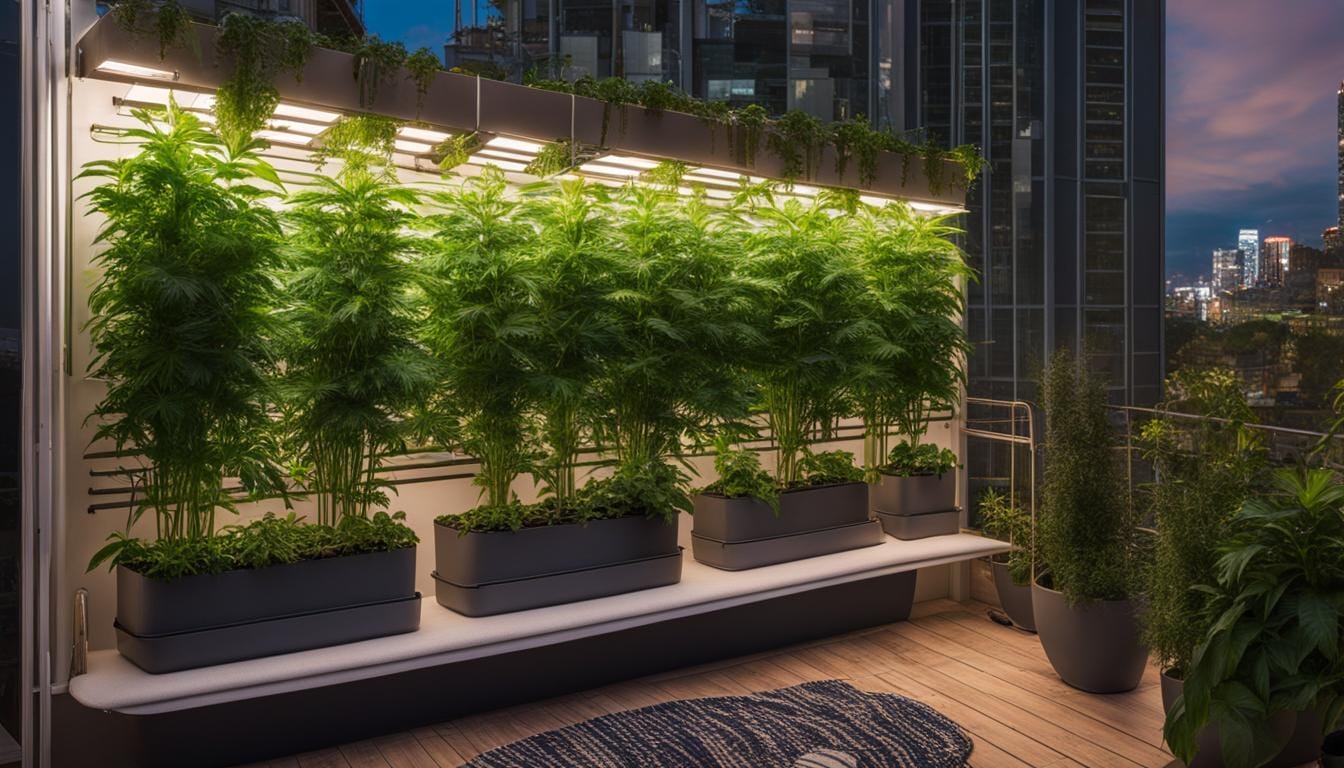
Harvesting and Drying Techniques
After months of hard work cultivating your urban cannabis garden, it’s finally time to harvest and dry your plants. Proper harvesting and drying techniques are essential to ensure your buds’ best possible quality and potency.
First, it’s crucial to know when to harvest your plants. The ideal time to harvest is when the trichomes (tiny resin glands on the buds) turn from clear to milky white, with some turning amber. This is when the THC content is at its highest, providing a more potent high.
Once you’ve established the right time to harvest, use scissors to cut off the branches and remove the large fan leaves. Leave the smaller leaves near the buds, as they contain valuable resin that will enhance the overall quality of your harvest.
Next, it’s time to dry your cannabis buds. The drying process is crucial to prevent moisture buildup, which can lead to mold growth and ruin your harvest. Hang your cannabis branches upside down in a cool, dark, and well-ventilated room. Ensure the room has a humidity level of around 50 percent, and the temperature is between 60 and 70 degrees Fahrenheit.
Avoid drying your buds too quickly or slowly, as this can affect the taste and potency. It usually takes around a week for your buds to dry completely, but you can check the progress by snapping a small branch. If it snaps cleanly, it’s ready to move on to the next step.
Once your buds are dry, it’s time to cure them. Curing involves storing your buds in an airtight container (such as a mason jar) and opening them daily for the first week or two to release any remaining moisture. This process allows the buds to develop their full flavor and aroma while improving the overall smoking experience.
Maintaining Security and Discretion
Urban cannabis farming comes with its own set of unique challenges. Apart from the space constraints and the proper strain selection, growers must also ensure security and discretion. Cultivating cannabis is still illegal in many states; hence, maintaining complete secrecy and avoiding attracting unwanted attention is the key to successful urban cannabis cultivation.
Here are some tips for maintaining security and discretion while growing cannabis in urban settings:
- Odor Control: The pungent aroma of cannabis plants can attract unwanted attention. Air filters or natural odor control methods, such as indoor plants, can help mask the smell.
- Light Leakage Control: Light leaking from grow tents can also alert neighbors or passersby. Covering the tent with thick, light-proof material or investing in a high-security grow tent can prevent light leakage.
- Privacy Considerations: Always ensure that your grow space is concealed from view. Windows that face public spaces should be blacked out or covered with blinds or curtains.
- Legal Considerations: Check your local laws regarding cannabis cultivation. If it is illegal, be discreet and avoid telling anyone about your cultivation activities.
- Invest in Security Equipment: Secure your grow space with a sturdy lock and an alarm system.
These security measures can help urban cannabis growers maintain discretion and avoid attracting unwanted attention.
Conclusion
There you have it—our comprehensive guide on cannabis cultivation in urban settings. By using the tips and tricks described in this article, you can successfully grow premium-grade marijuana in virtually any setting.
As we conclude this article, we want to stress the importance of responsible cannabis cultivation in urban settings. While it can be tempting to grow as many plants as possible, it is crucial to consider the impact on your community, the environment, and most importantly, your security.
Now that you know the secrets of urban cannabis farming, get your garden started with our collection of regular, feminized, and autoflower cannabis seeds.
FAQ
What is urban cannabis farming?
Urban cannabis farming refers to the practice of cultivating cannabis in urban environments. It involves growing cannabis plants in small-space environments such as apartments, rooftop gardens, or other limited areas in urban settings.
How can I successfully cultivate cannabis in urban settings?
Successful cannabis cultivation in urban settings requires careful planning and implementation of specific techniques. Factors like space efficiency, strain selection, lighting, watering, and pest management are crucial in achieving optimal growth and yield.
What strains are suitable for urban cannabis cultivation?
When choosing strains for urban cultivation, it is essential to look for characteristics that thrive in small-space environments. Compact or dwarf varieties like indica or hybrid strains are generally recommended for urban growers due to their manageable size and shorter flowering times.
What are some techniques for maximizing space efficiency in urban cannabis farming?
Urban cannabis growers can optimize their limited space through vertical gardening, hydroponics, and other innovative techniques. These methods utilize vertical space, reducing the footprint required for cultivation.
How do I set up an indoor grow space for urban cannabis cultivation?
Setting up an indoor grow space in urban settings involves lighting, ventilation, temperature, humidity control, and odor management. Proper equipment and techniques are crucial for creating a controlled environment that supports healthy plant growth.
What nutrients and soil preparation are necessary for urban cannabis cultivation?
Providing cannabis plants with the proper nutrients and soil preparation is essential for healthy growth. Using high-quality organic fertilizers and ensuring adequate soil pH levels are key factors in promoting optimal nutrient uptake.
How can I manage pests and diseases in urban cannabis cultivation?
Urban cannabis growers should proactively manage pests and diseases to prevent plant damage. Regular inspections, implementing integrated pest management strategies, and using organic pest control methods effectively address these issues.
What are the best practices for watering and irrigation in urban cannabis gardening?
Proper watering and irrigation techniques are crucial for your cannabis plants’ health and growth. Water plants thoroughly, but avoid overwatering. Techniques like drip irrigation or self-watering systems can help maintain proper moisture levels.
How important is light and photoperiod management in urban cannabis cultivation?
Light is essential for cannabis cultivation as it plays a crucial role in plant growth and development. In an urban setting, understanding how to optimize natural sunlight or properly utilize artificial lighting systems is vital for achieving the best results.
What are the best techniques for harvesting and drying urban-grown cannabis?
Proper harvesting and drying techniques are essential for preserving the quality and potency of your cannabis plants. Harvest when the trichomes are at the desired stage, and dry the buds in a well-ventilated space with ideal temperature and humidity conditions.
How can I maintain security and discretion in urban cannabis farming?
Maintaining security and discretion is crucial when cultivating cannabis in urban settings. Implementing measures like odor control, privacy considerations, and ensuring a low profile can help minimize risks and protect your cultivation operation.
Suggested Articles
;)
;)
;)




 11 Jul 2025
11 Jul 2025  4 min read
4 min read
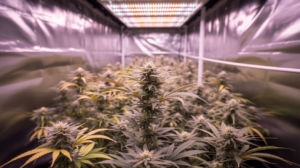

 December 19, 2023
December 19, 2023 


RESPONSES (0)
No responses yet. Be the first to respond!